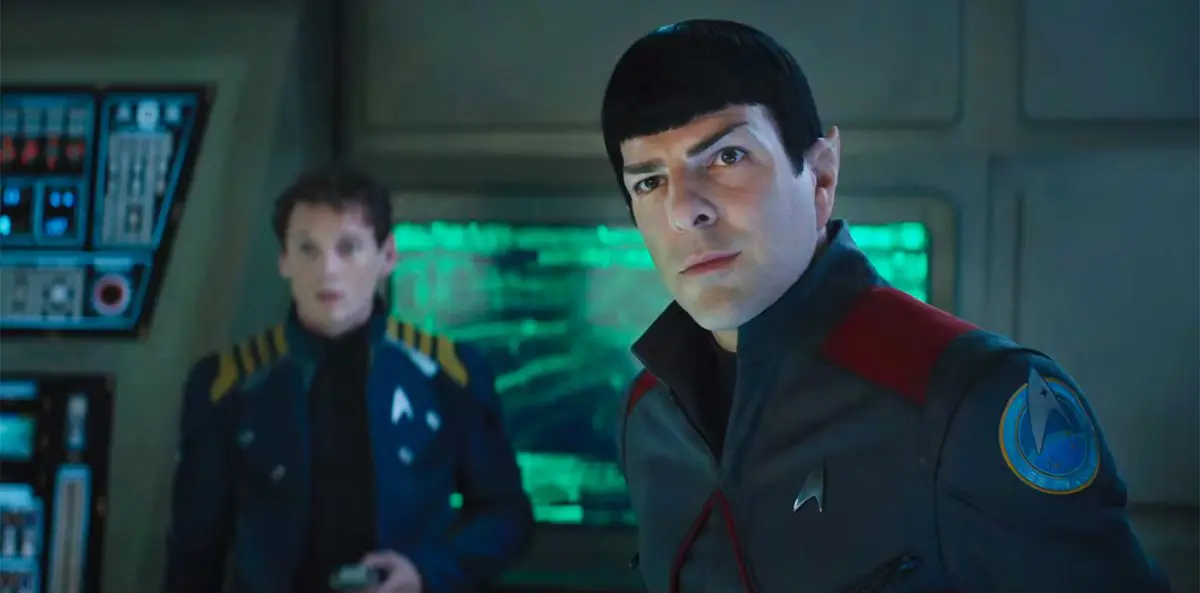This summer is just littered with gifts of good geeky movies rising above the cynicism and low expectations. Star Trek Beyond is the latest to do just that. It’s not perfect, of course, but it certainly tops the prior installment’s Khan-gate hiccups. There are plenty of stylistic choices made by director Justin Lin which are not for everyone, or possibly less appropriate for this genre. But the Fast & Furious director’s previous claims to fame turned out to be more of an advantage than not in this very Trek, very good installment of “new Star Trek.”
To address some entirely valid criticisms levied here and there from all manner of observers, the bulk of responsibility lies in Lin’s choices. This is to say, his skills and artistry cannot be doubted at this point, but his application of certain approaches to the action may leave some viewers unimpressed. This is most visible in the tightness of his shootouts and fight sequences. There is a lot of jumping, cutting, quick splicing and closeup action that can leave one’s head spinning. A disorientation of sorts hangs over these sequences. However, an examination of original-series episodes can expose similar traits, which places this in a grey area of effect. All-told, it is probably neutral and unremarkable. The shootouts, fights and other personal action scenes are neither the focus of the story, nor are they the memorable moments.
Those moments come in two, opposing formats: massive, grandiose and awe-inspiring spectacles and tiny, emotional, and/or important character and mythos tidbits which dance right along the fourth wall.
For anything this film lacks in the few Lin-driven potential weaknesses, it makes up for with more than enough huge positives. There is a responsible preservation of the mood, musical score, general aesthetic of the universe and ties to prior installments. The standout elements are found in an increased use of decent-quality humor right out of the gate, a poignant recognition in-story of the passing of Leonard Nimoy, the sheer mind-boggling scale of the Yorktown starbase (and all the requisite political and technological aspects within), a wonderful set of mini-arcs for various characters’ overall tales, a couple of excellent “classical music” moments, a lack of patronization which is refreshing after the lame subterfuge involving Khan last time, and a very appropriate, almost tear-jerking credit to recently departed Anton Yelchin (and, of course Nimoy).
The biggest strengths of the film are found, also, in Lin’s style. There may be no one better suited to present vehicle action, and having his talents applied to zooming starships is a treat. There is a certain element of scale and relative size/speed interplay that was critical for things like the astounding and marvelous Yorktown starbase. Lin was the ideal pick for that. Also, he infused a flair in the more spaceborne action sequences, but nothing to such an extent that it looked or felt like the “Fast & Furious in space,” which was suspected by the Internet hand-wringers.
Lin is not the only heavy-hitter in the mix, contributing to the clout and success this film displays. The casting of Idris Elba is a very remarkable advantage for this latest Trek. At first, one might wonder why a great actor like Elba would have to be relegated to being concealed inside major prosthetics. As the story unfolds, however, the presence and command of craft demonstrated by Elba comes clear. To say more would be a big giveaway, but fears of yet another minority actor being hidden away in an alien getup are diffused quite well.
This flick is a great shot at a Star Trek story. You should see it, and do so before your choices of 3-D, premium screenings and the like expire. The show is worth the price of admission for sure.
Review: 4/5
